Yiheyuan is the chinese name of the new Summer Palace which is a UNESCO World Heritage Site since December 1998 and is located in the Northwest of Beijing. Imperial pavillions were found in the area already in the 11th century but the present complex dates from the 18th century and was built under the regency of the Mandschu-Emperor Qianlong. Even though the Summer Palace is mainly associated with the Empress dowager Cixi who reigned the Middle Kingdom from 1861 until her death in the year 1902 and who reconstructed the palaces 1888 after they were plundered by foreign troops. She is also responsible for the construction of the Marble Boat, also called Clear and Peaceful Boat, which she built with money which was originally designated for the navy.
Only a few hundred metres east of the Yiheyuan lie the ruins of Yuanmingyuan, the original old Summer Palace. It was built in the early 18th century on the behalf of the Qing-Emperor Kangxi and was called the chinese Versailles by the Europeans. It was the biggest royal Park complex of the world with 200 pavillions and temples surrounding several lakes and springs. In 1860, as part of the second Opium War, the whole complex was devastated by french and british soldiers who were imprisoned and tortured on the behalf of Emperor Xianfeng. Attempts to rebuild the complex failed due to a lack of money.
Most people tend to visit the Yiheyuan, the new Summer Palace, but the old Summer Palace is also a popular destination for the chinese locals especially during the weekends.
I have originally intended to take the Metro till the Metro station Beigongmen and walk from there as it shouldn’t be too far but at the reception of my hotel I am told that it takes one and a half hours to go there by metro while the drive by taxi directly to the new Summer Palace takes only 40 minutes. As it is already late morning and I want to get to the Summer Palace, as soon as possible, I opt for the taxi.
Like many of his colleagues my taxi driver doesn’t speak a word of English and he drives with the windows wide open even though it is still quite cold outside. The streets are traffic-choked even on a Saturday and instead of 40 minutes the drive takes almost one and a half hours like I would have needed with the metro. Eventually we approach an area where many buses are parking and crowds of people are waiting or walking, all in the same direction. I show the taxi driver a note with the name of the new Summer Palace written in chinese characters, which the hotel concierge gave me. “Yiheyuan?” I ask. The taxi driver shakes his head. I decide to get off the taxi even though. This area doesn’t seem to be that wrong and, in case that this is not the new Summer Palace, it is probably easier to order a new taxi than to try to explain to him to take me to the right place.
I ask a group of western tourists if this is Yiheyuan, the new Summer Palace, what they affirm. I enter the complex through the East Palace Gate. In front of me lies the Kunming Lake “which covers approximately three quarters of the ground of the Summer Palace.” Many People are riding paddle boats on the lake or cross the Seventeen-Arch Bridge which is 150 metres long and thereby the longest bridge of the complex. It connects the east of the complex and South Lake Island, also called Nanhu Island. Afar I can see the Yu Quan Hill with the Yu Feng Pagoda which offers a stunning view. Most of the other people walk along the Long Corridor and explore the adjoining temples till reaching the Clear and Peaceful Boat also known as Marble Boat. I decide to take a Dragon Boat to the Clear and Peaceful Boat and walk in the reverse direction.
The Marble Boat is 36 metres long and has “a hull made of stone slabs.” It is really impressive and I take my time for the inspectation. Then I have a soup for lunch at a local restaurant which is better than the lunch I had yesterday at a local restaurant inside the Temple of Heaven Park. Afterwards I explore the area around the Marble Boat before entering the Long Corridor which “runs along the lake at the foot” of the Longevity Hill (Wanshou Shan). The Long Corridor “is 728 metres long” and has “14.000 pictures painted on its ceiling.” It is said to be “the longest painted gallery of the world.” According to legend every unmarried couple who walks through the corridor from one end to the other will be engaged thereupon. People are chilling along the Long Corridor which leads past the palace buildings and splendid apartments. From the top of the Tower of Buddhist Incense one has a stunnig view over the whole complex and the Kunming Lake with the Seventeen-Arch Bridge and the Beijing skyline afar.
The atmosphere in the Summer Palace complex during the low season or on weekdays, when here are not that many people, must be wonderful, tranquil and idyllic. But on today’s Saturday the area is overcrowded with tourists and loads of tour groups from all over the world which one can recognize by the national flags which are kept up by their group leaders. Most of them use loudspeakers and some even make it worse in using an amplifier. In some parts of the area where the alleys become more narrow people are pushing and I am glad when I finally reach the East Palace Gate where I started. Eventually I cross the Seventeen-Arch Bridge and explore Nanhu Island before walking back to the exit. There I meet a group of four young western tourists, three young females and a young male, who I have seen in the complex before. We get into conversation and as they also want to go back into the city by metro, we decide to go together.
They are from Canada. The young man and one of the females come from Edmonton, Alberta, one is from Vancouver on the canadian west coast and the other one from the Province of Ontario in the canadian east. For all four it is their first time in Asia. They got into Beijing last weekend and are very much thrilled about the city. They intend to stay in Beijing some more time, afterwards the young man wants to travel onwards to Xian and the three women intend to continue to Shanghai. He plans to stay in China for four weeks while the three females have six weeks time to explore the country.
We enter the Beijing Metro at the station Beigongmen. The Metro is great and very cheap. A ticket only costs two Yuan, no matter if you only ride for one station or if you travel across whole Beijing changing trains several times. The young man has downloaded a free Beijing Metro Map App onto his Smartphone which is fantastic and makes travelling with the Metro a lot easier as it offers a map of the whole Beijing Metro System. In the train we are talking about our plans for the next few days. When I mention that I intend to do a Hutong tour – a tour through one of the old, original chinese quarters – the young man tellsme that he has done a Hutong tour just by himself. He entered one of the Hutongs and got lost soon but loved it as he discovered a very pristine side of Beijing that way. The three women weren’t with him but one of them plans to do an organized Hutong Tour. When we bid farewell at Xizhimen station, she says: “Have fun and don’t get lost in a Hutong!” He responds: ” Have fun and do get lost in a Hutong, because that is the greatest fun!”
After changing trains into line 5 which takes me to my terminal station Puhuangyu, I see two adults who vacate their seats for three children who are about three to five years old. In the train there is acutally a sign which asks people to vacate their seats not only for elderly and disabled people but also for children. The three kids are sitting right in front of me and are watching me the whole time. Suddenly one of them starts to tell in English: “I like elephants!” and the other two children as well let me know what they like. I tell them in English what I like and apparently the people around me really like me to do that. When I look around everyone is smiling at me and when I leave the train at my terminal station several people say goodbye.
Again I don’t know the way from the Metro station back to my hotel and start to bargain with one the drivers of those chinese Tuk Tuks but he tries to rip me off and is not willed to accept less than ten Yuan which is twice as much as I paid yesterday. As I only have a 100-Yuan bill in my purse I am not in good position to get the price down to normal. I decide to go back down into the Metro station to ask there for the way, when two Chinese, a man and a woman, ask me: “Are you looking for your hotel, Miss?” “Yes”, I respond and show them the hotel business card. “We could take you there”, they offer. On the way they tell me about their English course and, when I let them know that I am from Germany, they want to know everything about the country, what is really worth to see, when the best season is to go there, where one can enjoy the best beer, where this big famous cathedral is located et cetera. Apparently they are glad to practice their English and they really take me to my hotel. Now I know the way from the metro station to my hotel!
Back in my hotel room I save my photographs, have a cup of tea and download the Beijing Metro Map App onto my Smartphone before leaving the hotel again to spend the evening at the Beijing Bookworm. I take a taxi again as I am told by the reception staff that I have to change trains more than once what makes me insecure because due to my memory I only have to change trains once. This time I recognize the area where the Beijing Bookworm is located already from the main road, so I tell the taxi driver to let me out there and walk the last few metres. The place is again well attended, the guests are mainly english-speaking chinese. I spend another couple of hours there, having a good time. Before leaving I ask the staff which is the best and easiest way to get back to my terminal Metro station and it comes out that I only have to change trains once but have to drive back two stations which is the easiest way even though. This way I make it back good and safe to my hotel.

Longevity Hill
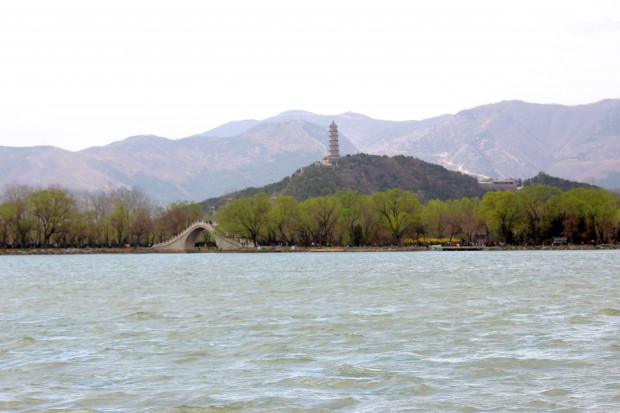
Kunming Lake with Yu Quan Hill and the Yu Feng Pagoda in the background
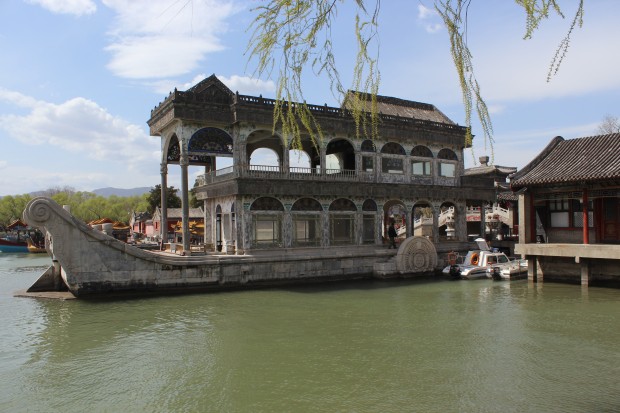
The 36 metres long Marble Boat has a hull made of stone slabs
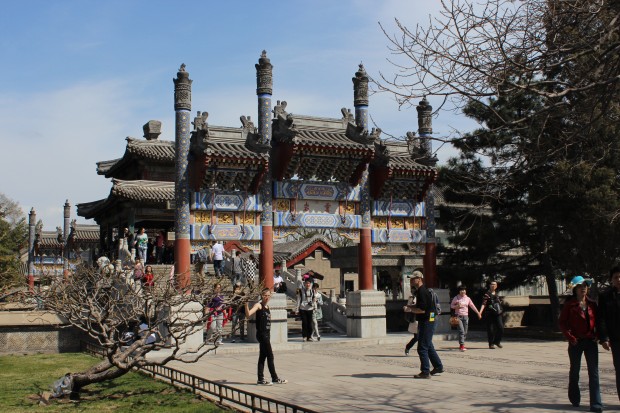
Picturesque Gateway
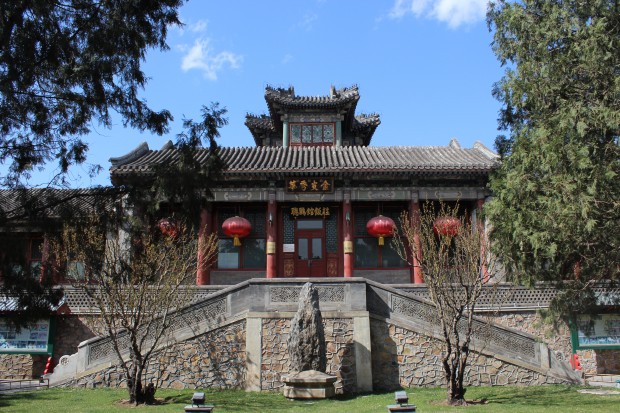
Pavillion
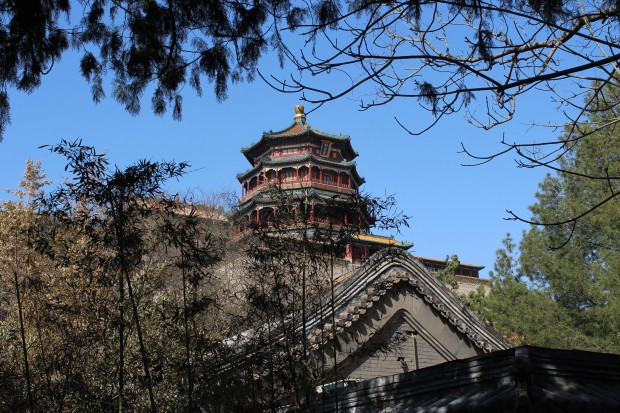
The Pavillion of Buddhist Incense
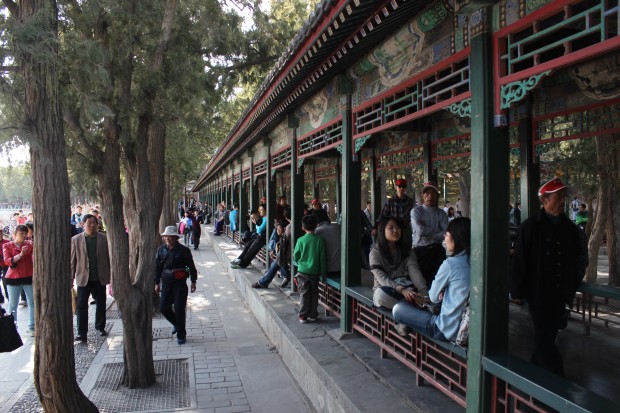
The Long corridor
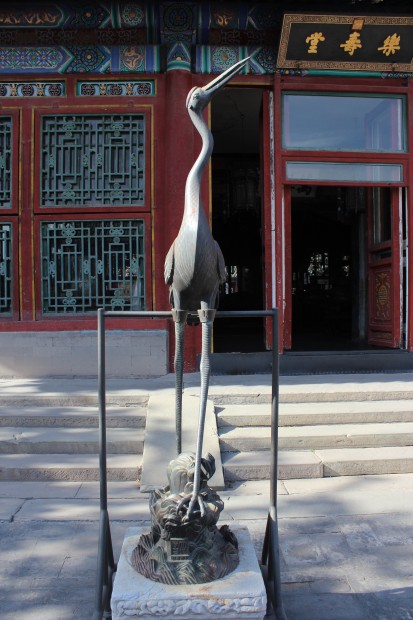
Cranes are a symbol of luck
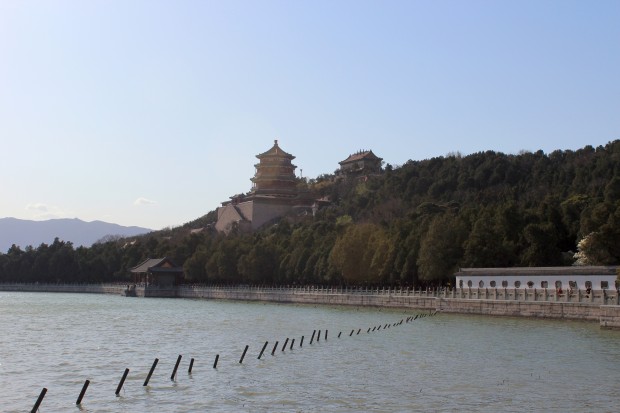
Longevity Hill and Kunming Lake in the afternoon sun

Kunming Lake, Yu Quan Hill with the Yu Feng Pagoda in the late afternoon
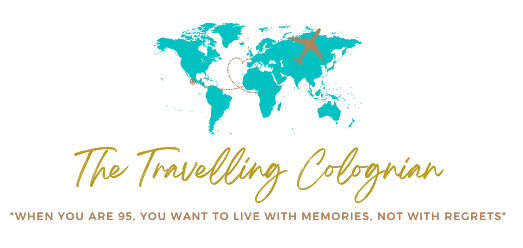
[…] Mauer, den Platz des Himmlischen Friedens und die Verbotene Stadt, den Himmelstempel und den Sommerpalast zu besichtigen und allenfalls ein paar Jahre später noch einmal wiederzukommen, um von dort aus […]
[…] the Hutong just by myself and get lost in the alleys like a canadian guy who I have met in the Summer Palace has recommended me, but I am feeling a bit like an intruder, so I choose to do it another way. […]
[…] my first two visits in Beijing I had explored the Temple of Heaven, the Summer Palace, Tiananmen Square and the Forbidden City, the Temple of Confucius, the Tibetan Lama Temple and the […]